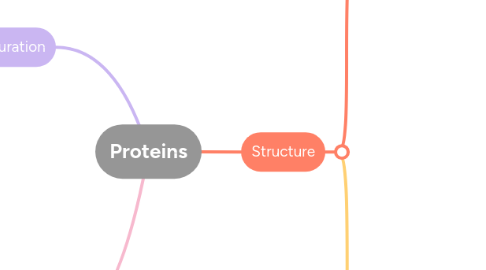
1. Protein Denaturation
1.1. Environmental factors that may destroy the interactions between the R groups of aminoacids, causing a change in shape and biological function.
1.2. Factors that causes Denaturation
1.2.1. Ph
1.2.2. Temperature
1.2.3. Heavy metals prescence
1.2.4. High concentration of Salt
2. Functions
2.1. Protein Synthesis
2.2. Energy source
2.3. Enzymes and Hormones prodcution
2.4. Immune system support
3. Protein / Polypeptide chain
4. R1
4.1. R2
4.1.1. R3
5. R1
5.1. R2
5.1.1. R3
5.1.1.1. R4
5.1.1.1.1. R5
6. R1
6.1. R2
6.1.1. R3
6.1.1.1. R4
7. Carboxyl group
8. Amino group
9. Side Chain
10. H
11. H
12. H
13. H
14. R
15. O
16. O
17. C
18. N
19. C
20. Structure
20.1. Made out of
20.1.1. 21 Aminoacids
20.1.1.1. How they form Proteins?
20.1.1.1.1. Aminoacids link toghether by Peptide Bonds, forming a Peptide.
20.1.1.2. How are they made?
20.1.1.2.1. Biological synthesis
20.1.1.2.2. Chemical synthesis
20.1.1.3. What are the "Building blocks of Proteins" made of?
20.1.1.3.1. Chemical composition
20.1.1.4. Types of Aminacids
20.1.1.4.1. Essential
20.1.1.4.2. Non-Essential
20.2. Structure levels
20.2.1. Primary structure
20.2.1.1. Amino acids are joined in a chain by Peptide Bonds.
20.2.2. Secondary structure
20.2.2.1. 3 ways of folding
20.2.2.1.1. Alpha helix
20.2.2.1.2. Beta sheet
20.2.2.1.3. Irregularly
20.2.3. Tertiary
20.2.3.1. Is held by different types of interactions between the R groups.
20.2.3.1.1. 1
20.2.3.1.2. 2
20.2.3.1.3. 3
20.2.3.1.4. 4
20.2.4. Quaternary
20.2.4.1. Final shape of the protein
